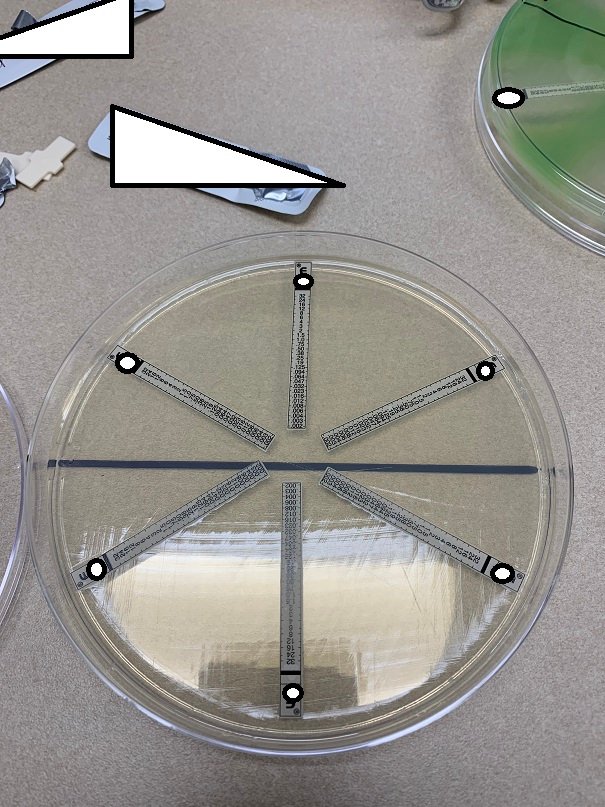What drugs are there?
In a land before time, how were minimum inhibitory concentration (MIC) determined? The answer is it wasn't pleasant. What you see in the picture below is an Etest. It's a somewhat antiquated way of performing susceptibilities for bacteria.
In short, the strips you see there contain antibiotics and they diffuse across the agar. The numbers represent drug concentration. The zone of inhibition (clearing) would determine the dosage (μg/mL or mg/L) need for treatment. You can see part of the finished culture in the upper right corner.

Due to the ongoing supply chain issues, we had to resort to older methods for certain testing. Our current antibiotic panels have limitations where some antibiotics results are not reliable. We have been sending many specimens out to our partner facilities as a result. Unfortunately, that's bad for revenue and our partners' inventories. In fact, there have been occasions when they are out of supplies as well.
Anyways, the picture shows a validation study in progress. This means that we are making sure the strips are working as intended before we use them on patient samples.
Here's the fun part, let's see if you can identify the following:
There are two drugs used in this picture. What are they?
A key clue to this mystery lies in the upper right corner of the picture. It shows you the color of the organism growing on the Mueller-Hinton plate. Think of a nosocomial infection.
Don't worry. There will be incentives.
Posted with STEMGeeks
Drugs?
!BEER
Yes, guess the drugs.
First, I have to read, what "nosocomial infection" is.
Looking for treatment:
Whelp.
I have no idea, what kind of antibiotic drugs there are. And I guess, you are not testing "rest" or "fluids" there
:)))
:v
View or trade
BEER.Hey @enforcer48, here is a little bit of
BEERfrom @isnochys for you. Enjoy it!Learn how to earn FREE BEER each day by staking your
BEER.Pseudomonas aeruginosa
But it's the drugs that's giving me doubt. Specific drug or drug class?
Penicillin and Cephalosporins (Cefepime).
Throwing in a general bucket list: Aztreonam, lipopeptides, Penicillin with anti betalactamase preps,fluoroquinolones and aminoglycosides.
The organism is correct.
I am looking for two specific drugs, but I can tell you it's not in the penicillin and cephalosporin classes.
Definitely one of those.
I forgot about carbapenems (meropenem), and maybe Aztreonam.
Other guess is under the aminoglycosides(gentamicin).
I'm cheating with using the CLSI manual :P
We throw in a battery of antibiotics instead of the ideal few selected options. None of what we do here is ideal but we try to be close so I don't really expect I'm going to get this right haha. Manual etest are done often here and like supply issues that's been happening, I have seen an increase of their use lately.
Those are not it.
Feel free to cheat. That's why I'm making it non-straight forward.
Ciprofloxacin
Imipenem
You mentioned it's not under Penicillin. Regarding the group above where you mentioned one of those, Penicillin + Tazobactam and other Penicillin combinations are out?
Maybe @scholaris and @nikv wants to try too :P
You got one!
Now, there's the other.
Amikacin and Ciprofloxacin
If Piperacillin class was out but not their combinations
Piperacillin Tazobactam and Ciprofloxacin.
Tobramycin and Ciprofloxacin, entertaining that maybe folks here just prefer amik as an aminoglycoside than Tobramycin.
Ciprofloxacin is one.
Now, find the other.
The other one may be Polymixin or Colistin
Then another Doripenem as the last one for the carbapenem class which I haven't tried.
It's not a carbapenem.
Doxycyline
Last attempt before I sleep on it.
UwU
Not Doxy.
Azithromycin
No.
I tried and failed on this one, unfortunately. 😩
I'm guessing Ciprofloxacin was the right one. Currently at work so I'll review on this later.
Ciprofloxacin is one.
This question definitely lies outside my domain of expertise. I know what penicillin is, and that's it... :D
Maybe this puzzle is too specialized.
At least for me it is... but I am not the only one ;)
The correct answers were Ciprofloxacin and Levofloxacin. We were doing validations for old school Etests in case clinicians request those drug values.
@Adamada was correct in naming one of them.
I would never ever have gotten the other one after I got Ciprofloxacin. I was going for two possible representative antibiotics under two different class and have completely eliminated the possibility that both mystery drug were going to be under the same class.
I debated whether or not I wanted to specifically say they were the same class from the start.
Since you got 1 of them, you get 50% votes!